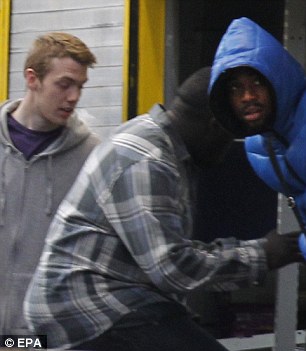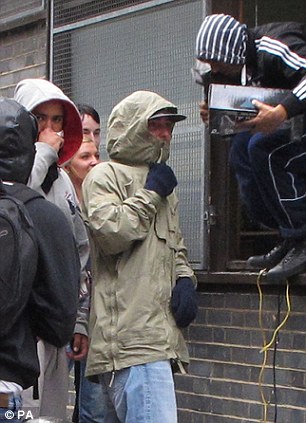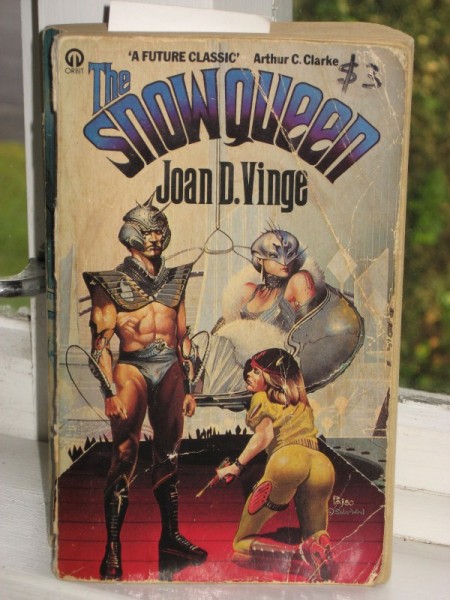August 11, 2011
Everything you need to know about the typical UK looter
… is contained in this Guardian article about the “fast track justice” system being used to process the arrestees:
One of the people dealt with by the court overnight included a woman with 96 previous convictions for theft who pleaded guilty to stealing alcohol, cigarettes and mobile phone accessories.
Linda Boyd, 31, was one of a series of defendants who appeared before Manchester magistrates court, which sat late into the night on Wednesday.
The court heard that she was drunk and had found an orange bin liner filled with the stolen goods in Manchester city centre, and began dragging it away, intending to share it with friends.
Her case was adjourned until 16 August, when she will be sentenced at Manchester crown court. Boyd stalked from the glass-walled dock telling the district judge who presided over the magistrates court to “go away, shut up.”
Yes, you did read that right, “a woman with 96 previous convictions for theft” was one of the people arrested in the aftermath of a night of rioting. That was 96 convictions, not arrests or charges. That’s an example of the sort of people who were delighted to discover that the police weren’t cracking down on vandalism or looting, and decided to get in on the act.
Canada’s debt crisis happened at a fortunate time
Father Raymond J. de Souza explains why Canada’s financial success story can’t be easily replicated by Europe or the United States:
The slaying of the deficit by Paul Martin saved Canada from the sovereign debt turmoil now afflicting Europe and America. While full credit is due to Mr. Martin, and it is gratifying to see other countries look to our experience, the turnaround in fiscal policy that Canada achieved in the 1990s is simply impossible to achieve in Europe or the United States in the near term. When we had our debt crisis, sparked by downgrades of the federal government’s credit rating between 1993 and 1995, we could make tough choices with the prospect of almost immediate results. No country has that option today.
That is only partly due to politics. Many have observed that the Liberal majority government of the day had the power to take dramatic action. That understates the case. Not only did the Grits have a majority, they had the near-certainty of another majority in 1997, given the disarray among the four opposition parties. The Chrétien government of 1995 was the most electorally secure government in Canadian history. No other country — not even Canada — has that circumstance today.
[. . .]
Europe and America face weak economic growth, rising debt service costs and no tax reforms to provide robust new streams of revenue. Even if granted the vast powers of the Chrétien government — not for nothing was it called the “friendly dictatorship” — neither Europe nor America have a path to slaying their deficits, aside from ever more brutal spending cuts. And indeed, if serious spending cuts add to unemployment and, in the short term, restrain economic growth, then the deficit may not shrink as welfare costs rise and revenues shrink.
Canada did well to respond to our crisis in the 1990s. We were lucky to have had it when we did.
US Navy reduces by one carrier group
Strategy Page has the story:
The U.S. Navy has disbanded one of its ten Carrier Strike Groups (SCGs), leaving only nine of them for the eleven aircraft carriers in service. This is a money saving measure, as nuclear powered aircraft (CVN) carriers spend twenty percent of their time out-of-service having maintenance done. Thus only 8-9 CSGs are needed at any one time.
The SCG is actually a complex organization. There is the CVN and its crew, and the CAW (Carrier Air Wing), which includes all the aircraft, pilots and support personnel. The CAWs do not stay with the same CVN, but move around. When a CVN goes in for maintenance, its CAW will move ashore and then to another carrier (usually one coming out of dry dock). Also part of a SCG are the escort ships (usually a destroyer squadron of 2-4 destroyers, cruisers or frigates) and one or two SSNs (nuclear attack subs). There is also one or two supply ships (carrying spare parts and maintenance personnel for all ships, as well as fuel for the escort ships.)
Until a few years ago, the U.S. had twelve carriers, but new ones are not being built quickly enough to replace the older ones that must retire (because of old age). Soon there will only be nine CVNs, and there will be cost cutting pressure to disband another SCG.
August 10, 2011
xkcd on the paradox of passwords
Contrasting the London police response now to the 1980s
Back in the bad old days, Mick Hume was active with the Revolutionary Communist Party. He contrasts the muscular (and, to be frank, horrifyingly racist and inhumane) police response to rioting in the Broadwater Farm riots of 1985 with the diffident, hyper-restrained actions of the London police this week:
Back then the police acted as the frontline of a state at war with sections of its own population, determined to hold the line at all costs in an all-out battle for control. By contrast, this week the police have more often looked as if they don’t even know where the line might be and are fearful of crossing it. They have allowed people to run riot. Even when they confronted looters, the abiding images were of officers waving their sticks around in the air like boys trying to appear tough without risking a real confrontation. As the man said, they looked ‘impotent’.
[. . .]
Recent events look less like an Eighties-style ‘uprising’ from below than a collapse of authority from the top down. The authorities have left a power vacuum that invited anybody with a brick or a shopping trolley to come and have a go. On Saturday police left people free to loot shopping centres in north London, supposedly while the Force focused on dealing with the riot in Tottenham. Yet as residents pointed out, they did nothing to stop the burning down of shops and flats there, either. Over the days that followed there were many complaints from angry shopkeepers of the Met standing back while their premises were robbed and fired.
So what did the police think they were doing while this was going on? One Met commander gave a revealing interview to Sky News, explaining that the policing of communities had changed a lot since the riots of 25 or 30 years ago. This time, he said, ‘we’re standing next to these people watching them cry because their businesses have been destroyed. We’re going to work with the partners in that local community to make sure we help them rebuild Tottenham. That’s what policing is all about.’ Call me old-fashioned, but that sounds more like a professional therapist or town planner than a police chief faced with civil disorder.
“It is effectively an invitation to riot”
Brendan O’Neill is disgusted with the official response to the rioters in London:
For a Londoner like me, the saddest sight of the past four days has been the extraordinary levels of central institutional capitulation to the rioters. The police have been deployed to vast swathes of London at around lunchtime every day, where they have advised shops, restaurants, pubs and cinemas to shut up, board up, hide their valuables, and send home their staff, ‘out of harm’s way’. From Harrow in the extreme north of London, best known for its posh school, to Camberwell in the south, police have effectively been calling on what they view as decent society to retreat, to go into hiding, to insulate themselves and their property from any possible interaction with The Thugs. Their thinking seems to be that if we close down normal life, if we evacuate the streets of shoppers and socialisers, then maybe the rioters will look around, scratch their heads, give up, and go home. Of course, it has had exactly the opposite effect.
Because when you shut down normalcy in response to a bit of recreational rioting, you actually give the rioters an extraordinary feeling of power over society. You endow their relatively small-scale and completely pointless violence with disproportionate strength and influence. You effectively say to them: ‘By burning bus-stops and smashing Santanders in Hackney, you can bring all of London to a standstill!’ And when it comes to youth who seem pretty determined to display a bit of swagger and cock-of-the-walk violence, that is like waving a red rag to a bull. It is effectively an invitation to riot. By publicly advertising its fears and weaknesses, by demonstrating its abjectness and its willingness to retreat in the face of small numbers of misguided youth, society actually empowers anti-social elements and inflames their desire to have a pop. You don’t have to be a rocket scientist to know that if you skulk away from your post, then others will feel tempted to tiptoe towards it.
Indeed, it seems largely to have been this institutional cowardice, this political wretchedness, the bizarre police-and-mayoral strategy of shutting down London in response to historically quite minor disturbances, which sustained the rioting over four days and nights and allowed it to spread around the country. Certainly the rioting is not being sustained by its pursuit of a political agenda (it has none) or by public backing (it has none. And no, sympathetic columns in the Guardian written by people who live nowhere near Hackney or Salford do not count as public backing.) Rather, it was the initially startled, hands-off attitude taken by the police, followed by the strategy of capitulation, which, in the words of one academic observer, probably filled the youths with an ‘adrenalin-fuelled euphoria’. The real story of these riots, if we look at them coolly, is not so much the fury of those on the outskirts of society, but rather the cowardice of those who are supposed to guard and uphold the centre of society. The riots are a product of the interplay between this institutional incoherence and the self-pitying politics of victimhood amongst the welfare state-raised kids ‘out there’.
English in India
An interesting post at The Economist‘s Johnson blog looks at the evolution of “Hinglish”:
Once the British left India, Anglo-Indian died a natural death. In its place came a chutnified Indian English that mixes American and British versions of the language with vernacular words and syntax and direct translations of phrases.
A glimpse of the breadth of influences in contemporary Indian English can be found at the delightfully-named Samosapedia. A cross between Hobson-Jobson and Urban Dictionary, the website modestly describes itself as “the definitive guide to South Asian lingo” and invites users to “catalog and celebrate the rich, diverse and ever-evolving landscape of this region’s shared vernacular”. Over 2,500 words and phrases have been added since Samosapedia was launched at the end of June.
Samosapedia is a lot of fun. It is also fascinating. Many phrases it lists are common across India: A “chaddi buddy” (lit: underwear friend) is someone you’ve known since childhood; “kabab mein haddi” (lit: a bone in the kebab) is a third wheel with better imagery; an “enthu cutlet” (lit: an enthusiastic mincemeat croquette) is an overly earnest soul. But then there are those that come from regions, sub-cultures and even neighbourhoods. “Talking-shalking” highlights the Punjabi fondness for rhyme. “Sandra from Bandra” is a stereotype from a predominantly Catholic suburb of Mumbai. “Send it” refers to smoking pot.
The entries at Samosapedia also offer an insight into how Indian culture is changing. “Traditional with modern outlook”, often found in matrimonial ads, encapsulates the evolving nature of arrange marriage—or “love-cum-arranged marriage”—where the prospective bride and groom have far greater say in their partners than earlier generations did. “Behenji-turned-mod” is a condescending term for a traditional woman transitioning from fusty and oily-haired to a more urban, socially acceptable version of herself. It is telling that these undoubtedly modern but widely-used phrases exist in Hinglish, a portmanteau of Hindi and English.
Lots of links in the original post to various entries in Samosapedia.
China’s second-hand aircraft carrier puts to sea for initial trials
The Shi Lang, formerly the Varyag, is undergoing a set of sea trials:
China’s first aircraft carrier began sea trials on Wednesday, the state-run Xinhua news service reported, a highly symbolic step in what is certain to be a years-long effort to create a carrier presence in the Pacific waters off its coast.
The carrier, once known as the Varyag, left Dalian, its northeast China port for what analysts said would be a test of its rudder, propulsion system and other basics. Xinhua’s two-sentence report stated only that the carrier would make a short voyage before returning to Dalian for further tests.
The Chinese Defense Ministry said last month that the carrier would be used largely for scientific research and training. Foreign military analysts say it could be a decade or more before the Chinese can deploy and operate a true fleet of carriers, the most costly and complex weapons systems in any nation’s arsenal.
August 9, 2011
(Temporarily) Drying out USS Monitor
John Tierney reports on the conservation efforts on one of the most revolutionary warships in history:
[In 1861] a shipyard in Greenpoint, Brooklyn, launched not merely an ironclad but an entirely new kind of warship. The U.S.S. Monitor had no masts and no line of cannons. It was essentially a submarine beneath a revolving gun turret, something so tiny and bizarre-looking that many experts doubted the “cheese box on a raft” would float, much less fight.
But somehow it survived both the Navy bureaucracy and a broadside barrage to become one of the most celebrated ships in the world. Its designer and crew were the 19th-century celebrity equivalent of astronauts. Long after the ship sank in a storm off Cape Hatteras, N.C., the turret remained a cultural icon: an “armored tower” in Melville’s poetry, an image on book covers and film posters, a shape reproduced in items from toys to refrigerators.
Now the original turret, which was recovered from the ocean floor nine years ago and placed in a freshwater tank to protect it from corrosion, is on display again. It has been temporarily exposed to the air so that it can be scraped clean — very carefully, in front of museum visitors and a live webcam — by a team of researchers at the U.S.S. Monitor Center of the Mariners’ Museum here in Newport News. The team expects to have nearly all the barnacles and sediment removed by the end of this month, giving the public a new look at the dents from the Confederate cannonballs and shells that would have sunk any ordinary ship of its day. Then the turret will be submerged again in fresh water for 15 more years, until enough ocean salt has been removed from the metal to allow it to face the air permanently.
To every action, there’s a reaction
The rioters in Toronto and Vancouver were frequently caught on camera, and the photos were posted on the various photoblogging sites. Many people were identified this way, and some of them were charged as a result. Londoners are responding in the same way, with sites like http://catchalooter.tumblr.com/ where photos are being posted from the last few nights’ mayhem.


Every action does have a reaction, though, as rioters and even “innocent bystanders” are becoming more likely to attack anyone with a camera. This means a much greater risk for would-be citizen journalists (and professional journalists), as the police generally try to surround and contain mobs (when they don’t just evacuate altogether, of course). If someone in the mob decides that you’re “the enemy”, you won’t have much support — don’t risk your life just to get a “good shot”.
Update: Speaking of police unwillingness to protect civilians, there’s this account:
Cypran Asota, who has run the Boots opticians for 25 years, told the London Evening Standard how he watched as the shop was destroyed.
He said police stood by yards away, adding: ‘White boys ripped off the shutters, then a group of around eight or nine children went in and stole the day’s takings.
‘I ran back over the road to plead with them, this is my livelihood and I have to protect it, but they kept coming back in. They must have got away with £15,000 worth of frames. My insurance doesn’t cover acts of terrorism.
‘All the time the police were about 15 yards away, just watching. They didn’t do anything to stop it. They looked more scared of those kids than I was.’
Shopkeeper Shiva Kadih, 39, told the Standard he had ‘nothing left’ as witnesses said they prevented an attempt to burn down the shop as police watched nearby.
“Mobs rule as police surrender streets”
The rioting in London has gotten worse, and more widespread. The media are having trouble coming up with ways to explain why it’s happening, with the most common being pent-up anger at the police:
The politicians are lucky, though, for the greater share of anger is being directed at the Metropolitan Police. The accusation, also voiced after the riots (ostensibly against public spending cuts) that took place in central London in the spring, is that the Met’s approach to civil disorder amounts to standing by for fear of provoking even more vicious rioting, with a view to catching culprits afterwards through the use of CCTV footage. The front-page headline in today’s Times, “Mobs rule as police surrender streets”, captures the mood, though the Met, alternately accused of brutality and laxity in recent years, are in an invidious position.
[. . .]
Second, policing will become a much hotter topic of political discourse. It is curious that it is not already. The theology of academic selection and university funding obsesses the political and media classes but the polling evidence is clear: crime is a bigger worry for voters than education. So expect much tardy reflection among politicians about the police. They will grapple, in particular, with the question of whether successive, well-intentioned efforts to check and soften the Met (such as the Scarman report in the 1980s, the McPherson report in the 1990s, the rebranding of the force as a “service”, the proliferation of “community support officers” and the like) have resulted in an unduly tentative approach to policing the streets. Whatever the answer, the debate will no longer take place at the margins of politics.
I’m sure it’s not the only reason, but if the way opinions about the police soured after the bungled response to the G20 protests in Toronto are a guide, it’s going to be an awful August for the Metropolitan Police. Being a cop on the street can be a tough job, but if you lose the support of the people, you’re more like a soldier in an occupied zone than an ordinary police officer. Toronto’s police lost a lot of respect — and a lot of quiet support — for their schizophrenic actions during the G20. London’s police may lose more than that.
Update: When I wrote that the rioting had become more widespread, I wasn’t exaggerating:

Fish. Barrel. Bang
If you’ve never seen these god-awful science fiction book covers, you’ll quickly understand why this website will have a long, long list of candidates for mockery:

Kelly Comments: Considering that later editions have an absolutely gorgeous cover by Michael Whelan, I’m always a bit horrified to see the travesty on my own copy of the book. It looks like a poster for some kind of low-budget 70s bondage. My poor eyes!
H/T to Lois McMaster Bujold, who said “SF covers more dire than my own. Some of these even make me feel better . . .”




